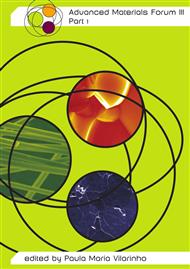p.1068
p.1073
p.1078
p.1083
p.1087
p.1094
p.1099
p.1103
p.1111
The Modulus Formalism Used in the Dielectric Analysis with Optical Characterization of Hydroxyapatite and CaTi4P6O24 Ceramic Formers by Dry Ball Milling
Abstract:
The bioceramic hydroxiapatite [Ca10(PO4)6 (OH)2 – HAP] is the main mineral constituent of teeth and bones with excellent biocompatibility with hard and muscle tissues. These materials exhibit several problems of handling and fabrication, which can be overcome by mixing them with a suitable binder. The dry milling process of fabrication of HAP presents the advantage that melting is not necessary and the powder obtained is nanocrystalline. The HAP has been obtained from three different experimental procedures (HAPA: Ca(H2PO4)2 + Ca(OH)2; HAPB: Ca(H2PO4)2 + CaCO3; and HAPC: CaHPO4 + CaCO3). In the reactions HAPA and HAPB the hydroxiapatite phase was obtained after 5, 10 and 15 hours of milling and after 15 hours in the reaction HAPC. In order to improve the mechanical properties of HAP, calcium phosphate ceramics with titanium (CaP-Ti) has been prepared by dry ball milling (Ca(H2PO4)2 + TiO2). The calcium titanium phosphate phase, CaTi4P6O24, was obtained. The dielectric study in function of frequency, at constant temperature of the ceramics, was made using the Modulus (M*) formalism and a distribution of relaxation times was observed. The values of the dielectric constant of the ceramics measured at room temperature are between 5.04 (CaP-Ti_5H) and 13.70 (HAPA_10H). The structure of the samples was studied by X-Ray diffraction, infrared and Raman scattering spectroscopy.
Info:
Periodical:
Pages:
1087-1093
Citation:
Online since:
May 2006
Price:
Сopyright:
© 2006 Trans Tech Publications Ltd. All Rights Reserved
Share:
Citation:


